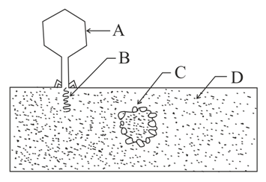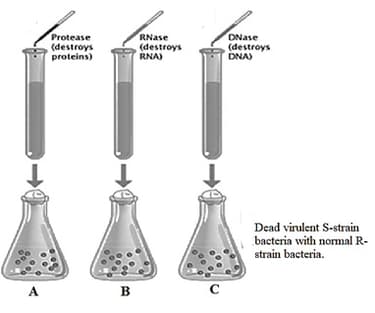Which was the first genetic material to be discovered, whether DNA or RNA?
Important Questions on Molecular Basis of Inheritance
Identify the labels marked A, B, C, D in a sequence in the illustrated diagram.

A bacterial strain was heat killed. Another strain (living) was taken and mixed with this S strain. This mixture of strains were injected into mice. Which of the following are observed by Griffith?
I. The cells of strain were dead in dead mice.
II. The bacterial cells without polysaccharide coat are transformed into virulent strain in the injected mice.
II. Griffith could not find living strain in the body of dead mice.
IV. Griffith could find living strain in the body of dead mice.
The correct combination is:
Lederberg and Tatum found that the bacterium donates entire genetic material to recipient
Ehrenberg established link between bacteria and infectious diseases
Pasteur showed about the significant changes of nature brought by bacteria
Griffith discovered recipient cells of bacteria acquire previous characters

(A) Transformation was not inhibited by protease and DNase.
(B) Transformation was affected by protease and DNase.
(C) Transformation was affected by RNase.
(D) Transformation was affected by DNase.
A) A nitrogen base is linked to the sugar through peptide linkage to form a nucleoside.
B) A polynucleotide chain has free phosphate moiety at end of sugar.
C) In RNA, nucleotide residue has an additional - group at the position of the ribose sugar.
D) It is observed that in DNA, the A: T ratio and C: G ratio are not constant all the time.
| Column - I | Column - II | ||
| i | Griffith | p | Lac Operon |
| ii | Jacob and Monad | q | DNA is the genetic material |
| iii | Meselson and Stahl | r | Transforming principle |
| iv | Hershey and Chase | s | DNA replicates semi-conservatively |
i. British biochemist Frederick Sanger introduces his 'plus and minus' method for DNA sequencing.
ii. American scientists Walter Gilbert and Allan Maxam introduce their method of DNA sequencing using chemical processes to terminate DNA strands.
iii. Swiss physician Friedrich Miescher discovers and isolates DNA
iv. Canadian-American researchers Oswald Avery and Colin Munro MacLeod, along with American geneticist Maclyn McCarty, working on experiments on pneumococcal bacteria, establish that DNA could transform the properties of cells.
v. American biologist James Watson and English physicist Francis Crick discover the double helix when solving the three-dimensional structure of DNA, working from crystallographic data produced by Rosalind Franklin and Maurice Wilkins.
A student grew virus in three different media containing and DNAase separately and allow this virus to attack to E. coli. The series of observation made by the students are as follows:
a) labelled phage particles were produced in E. coli.
b) containing phage particles were produced E. coli.
c) Phage particles were observed in E. coli.
d) was not observed in phage particles produced by E. coli.
e) was not observed in phage particles produced by E. coli.
The correct observations are
